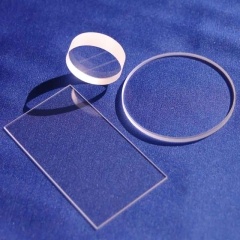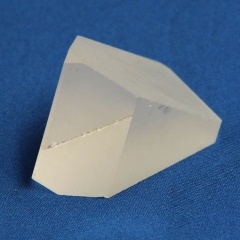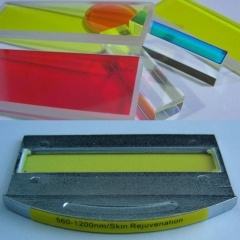Made from BK7 material, which has transparent range from 330-2100nm. The refractive index is 1.5168 at 587.6nm. The BK7 window has good performance over visible and near IR spectrum for most application.
Achromatic Waveplate Achromatic Waveplates(Retarders), AWP is composed of one piece of Crystal Quartz and one piece of Magnesium Fluoride, MgF2.
Barium fluoride (BaF2) shows good optical transmission over UV-IR windows in 0.15μm~12.5μm.
MgF2 windows are used in the UV, visible and IR ranges, with approximately 94% transmission from 200 - 1000 nm, and approximately 95% transmission from 1-6µm
CaF2 has transparent range from 170-7800nm. The refractive index is 1.399 at 5000nm. 1. Low absorption coefficient 2. High damage threshold, 3. Low Dispersion (with an Abbe Number of 95) 4. Low fluorescence 5. Excellent water, chemical, and heat resistance
Positive meniscus lenses is convex-concave lens thicker at the center than at the edges, which frequently used for beam focusing applications.
Negative meniscus lenses is convex-concave lens thinner at the center than edges, which frequently used for beam expanding applications.
product orgin:
Chinashipping port:
Fuzhou Chinapayment:
T/T Payment, Western Union
Positive meniscus lenses and Negative meniscus lenses
Positive meniscus lenses is convex-concave lens thicker at the center than at the edges. They are used to minimize spherical aberration. When used in combination with another lens, it’s will shorten the focal length, and increase the NA of system.
1. Frequently Used for Beam Focusing Applications
2. Minimizes the Increase in Spherical Aberrations for Multi-Element Systems
Negative meniscus lenses is convex-concave lens thinner at the center than edges. They increase the divergence of the beam without introducing any significant spherical aberration. When used in combination with another lens, they will increase the focal length, and decrease the NA of the system.
1. Frequently Used for Beam Expanding Applications
2. Minimizes the Increase in Spherical Aberrations for Multi-Element Systems
Specification:
Material:
Grade A optical glass or Fused Silica
Dimension Tolerance:
±0.1mm(Standard), ±0.05mm(High Precision)
Center Thickness Tolerance:
±0.1mm(Standard), ±0.05mm(High Precision)
Paraxial Focal Length:
±2%
Surface quality:
60/40(Standard), 20/10(High Precision)
Clear Aperture:
>85%
Surface Figure:
λ/2(Standard), λ/4(High Precision) @633nm
Centration:
3 arc minutes
Bevel:
<0.25mm×45°
Coating:
Upon requirement
Note for Spherical Lens:
a. Other optical glass materials from Schott, Ohara, Hoya or Chinese CDGM, UVFS from Heraeus, Corning, Germanium, Silicon, ZnSe, ZnS, CaF2, Sapphire are also available upon request .
b. Custom-made Spherical Lenses at any size from diameter 1.0 to 300mm are available upon request.
One stop service for Vision Optics-Laser Optics-Medical Optics-5G Optical Communication-Military Optics.


| Typical Sizes | |||||||
| Item No. | Φ(mm) | f(mm) | R1(mm) | R2(mm) | Tc(mm) | Te(mm) | Fb(mm) |
| Material | N-BK7 | ||||||
| MNP201 | 25.4 | 100 | 33.42 | 89.95 | 4 | 2.39 | 96.01 |
| MNP202 | 25.4 | 150 | 42.36 | 89.95 | 4 | 2.95 | 145.2 |
| MNP203 | 25.4 | 200 | 48.75 | 89.95 | 3.5 | 2.72 | 194.51 |
| MNP204 | 25.4 | 250 | 83.95 | 235.5 | 3.5 | 2.88 | 245.97 |
| MNP205 | 25.4 | 300 | 94.19 | 235.5 | 3.5 | 2.98 | 296.27 |
| MNP206 | 25.4 | 400 | 110.92 | 235.5 | 3.5 | 3.11 | 396.06 |
| MNP207 | 25.4 | 500 | 124.17 | 235.5 | 3.5 | 3.19 | 496.16 |
| MNP208 | 25.4 | 1000 | 278.34 | 600 | 3.5 | 3.3 | 993.7 |
| MNN201 | 25.4 | -100 | 89.95 | 32.51 | 3 | 4.68 | -98.79 |
| MNN202 | 25.4 | -150 | 89.95 | 41.21 | 3 | 4.11 | -148.06 |
| MNN203 | 25.4 | -200 | 89.95 | 47.64 | 3 | 3.82 | -197.82 |
| MNN204 | 25.4 | -250 | 235.5 | 83.18 | 3.5 | 4.13 | -248.62 |
| MNN205 | 25.4 | -300 | 235.5 | 93.33 | 3.5 | 4.03 | -299.04 |
| MNN206 | 25.4 | -400 | 235.5 | 109.65 | 3.5 | 3.9 | -397.33 |
| MNN207 | 25.4 | -500 | 235.5 | 122.74 | 3.5 | 3.82 | -496.94 |
| MNN208 | 25.4 | -1000 | 600 | 277.16 | 3 | 3.1 | -995.3 |
 Fused Silica Windows and Quartz Windows
Fused Silica Windows and Quartz Windows
Fused Silica material Advantages With Good UV and IR transmission, Low thermal expansion, providing stability and resistance to thermal shock, Wider thermal operating range and High laser damage threshold make Fused Silica windows could used for Laser, Medical, imaging etc. application.
 Neutral Colored Glass Filters
Neutral Colored Glass Filters
Neutral Colored Glass Filters are named based on the average transmissivity characteristics in 400nm to 700nm wavelength with 2mm thick For example ZAB70 means 70%.
 LiNbO3 and MgO-LiNbO3 Nonlinear Crystal
LiNbO3 and MgO-LiNbO3 Nonlinear Crystal
LiNbO3 crystal is widely used as frequency doublers for wavelength > 1mm and optical parametric oscillators (OPOs) pumped at 1064 nm.
 BK7 and Fused Silica Glass Schmidt Prisms
BK7 and Fused Silica Glass Schmidt Prisms
Schmidt Prisms Schmidt prisms are used to invert and revert an image to angle of 45°. The 45° deviation makes Schmidt prisms useful in eyepiece assemblies and imaging systems requiring a path bend. 1. Ray Deviation of 45° 2. Right Handed Image 3. Combine with Half-Penta Prism to Create Pechan Prism
 IPL Filters for Intense Pulsed Light Machine
IPL Filters for Intense Pulsed Light Machine
IPL filter is the key optical element for IPL (intense Pulsed Light) machine, Their main application: 1. Photrevujenation 2. Hair removal 3. Vascular 4. Acne treatment.
 Cut-Off Colored Glass Filters
Cut-Off Colored Glass Filters
Cut-off Colored Glass Filters The glass is named based on spectral characteristic of which is represented by the wavelength transmission limit. Short Pass Color Glass Filters Long Pass Color Glass filters
friendly links :
copyright © 2024 WTS PHOTONICS CO., LTD.all rights reserved. powered by dyyseo.com .
wts photonics